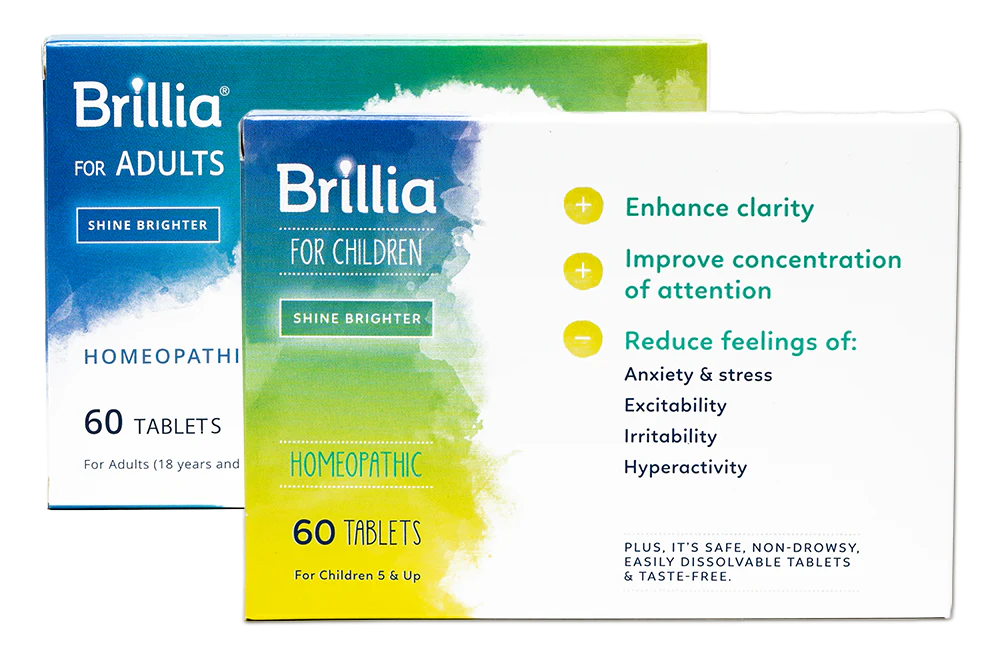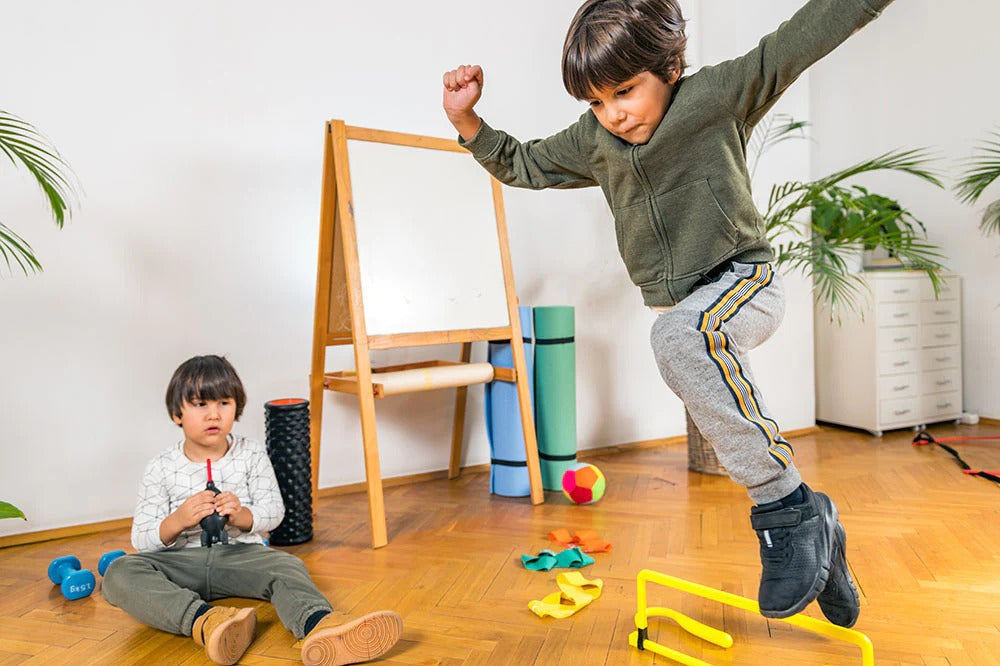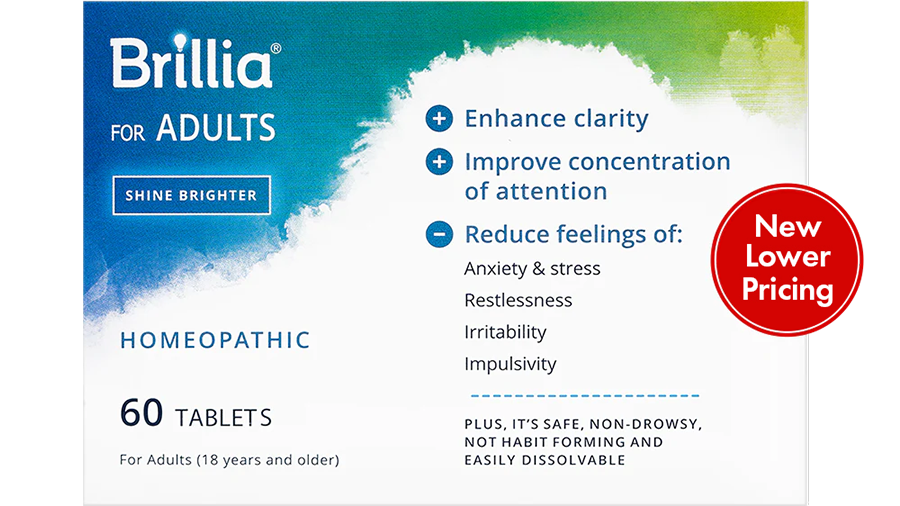Hyperactivity
See why so many choose Brillia when compared to other medications.

Brillia for hyperactivity
Left unaddressed, hyperactive behavior can interfere with daily tasks, including schoolwork for children, and making friends. Some habits that may help reduce hyperactivity include getting enough sleep, eating nutrient-rich food, exercising, and minimizing screen time. No prescription or diagnosis is needed to take Brillia. Anyone experiencing symptoms can benefit from taking Brillia.

Hyperactivity signs and symptoms in children, teens and adults:
- Constant fidgeting
- Can’t sit still in quiet settings
- Lack of concentration
- Excessive talking, interrupting
- Excitability, impulsivity
- Risky or dangerous behavior

What causes hyperactivity?
Factors that may contribute to hyperactivity include genetics, the environment, or problems with the central nervous system during critical moments of development. Some studies show that hyperactive behavior can also stem from an imbalance of the S100B protein, a regulator of many different brain processes, including mood. Brillia helps to regulate the activity of this protein and effectively reduce symptoms of ADHD like hyperactivity and excitability. This regulation targets the source so that no other systems in the body are impacted.
Brillia’s unique and impactful active
ingredient reduces hyperactivity without
the use of harsh synthetic chemicals.
Watch: A Brillia success story
See how Brillia compares
Brillia VS. Adderall
Brillia
Active Ingredients >
Lapine S-100 immune globulin
How It Works
Lapine S-100 are antibodies that bind to the S100B protein to help regulate their activity and reduce the symptoms of hyperactivity and irritability. As a result of the regulating effect of Brillia on the protein S-100, the level of monoamines (dopamine, norepinephrine, serotonin) in different parts of the brain also normalizes.
NO Harmful Side Effects
NO Interactions
Adderall
Active Ingredients >
Dextroamphetamine sulfate, amphetamine sulfate dextroamphetamine saccharate, and amphetamine (D,L)-aspartate monohydrate
How It Works
With Adderall, a central nervous stimulant binds to norepinephrine and dopamine receptors in the brain in addition to epinephrine receptors in the adrenal gland. This binding effect increases the levels of these neurotransmitters in the brain, which is thought to improve the user’s concentration and alertness.
Side Effects
Interactions
Brillia VS. Focalin
Brillia
Active Ingredients >
Lapine S-100 immune globulin
How It Works
Lapine S-100 are antibodies that bind to the S100B protein to help regulate their activity and reduce the symptoms of hyperactivity and irritability. As a result of the regulating effect of Brillia on the protein S-100, the level of monoamines (dopamine, norepinephrine, serotonin) in different parts of the brain also normalizes.
NO Harmful Side Effects
NO Interactions
Focalin
Active Ingredients >
Dexmethylphenidate hydrochloride
How It Works
Blocks the reuptake of norepinephrine and dopamine in the brain to speed up brain activity
Side Effects
Interactions
Brillia VS. Ritalin
Brillia
Active Ingredients >
Lapine S-100 immune globulin
How It Works
Lapine S-100 are antibodies that bind to the S100B protein to help regulate their activity and reduce the symptoms of hyperactivity and irritability. As a result of the regulating effect of Brillia on the protein S-100, the level of monoamines (dopamine, norepinephrine, serotonin) in different parts of the brain also normalizes.
NO Harmful Side Effects
NO Interactions
Ritalin
Active Ingredients >
Methylphenidate
How It Works
With Ritalin, a central nervous stimulant increases the availability of the neurotransmitters norepinephrine and dopamine in the brain (faster-acting than Adderall)
Side Effects
Interactions
Brillia VS. Concerta
Brillia
Active Ingredients >
Lapine S-100 immune globulin
How It Works
Lapine S-100 are antibodies that bind to the S100B protein to help regulate their activity and reduce the symptoms of hyperactivity and irritability. As a result of the regulating effect of Brillia on the protein S-100, the level of monoamines (dopamine, norepinephrine, serotonin) in different parts of the brain also normalizes.
NO Harmful Side Effects
NO Interactions
Concerta
Active Ingredients >
Methylphenidate hydrochloride
How It Works
Regulates the neurotransmitters norepinephrine and dopamine, but it works slower with an extended-release function. By allowing these brain chemicals to rise slowly, the body is able to use more, allowing for better focus and attention.
Side Effects
Interactions
Brillia VS. Dexedrine
Brillia
Active Ingredients >
Lapine S-100 immune globulin
How It Works
Lapine S-100 are antibodies that bind to the S100B protein to help regulate their activity and reduce the symptoms of hyperactivity and irritability. As a result of the regulating effect of Brillia on the protein S-100, the level of monoamines (dopamine, norepinephrine, serotonin) in different parts of the brain also normalizes.
NO Harmful Side Effects
NO Interactions
Dexedrine
Active Ingredients >
Dextroamphetamine sulfate
How It Works
Increases the feel-good neurotransmitters dopamine and norepinephrine to increase brain activity and improve focus
Side Effects
Interactions
Brillia VS. Vyvanse
Brillia
Active Ingredients >
Lapine S-100 immune globulin
How It Works
Lapine S-100 are antibodies that bind to the S100B protein to help regulate their activity and reduce the symptoms of hyperactivity and irritability. As a result of the regulating effect of Brillia on the protein S-100, the level of monoamines (dopamine, norepinephrine, serotonin) in different parts of the brain also normalizes.
NO Harmful Side Effects
NO Interactions
Vyvanse
Active Ingredients >
Lisdexamfetamine
dimesylate
How It Works
With Vyvanse, a fast-acting central nervous system stimulant regulates the neurotransmitters norepinephrine and dopamine to promote focus and attention. The drug makes the body absorb the chemical lysine first before feeling the effects of the stimulant. This means that the drug sticks around in the body for a longer period of time.
Side Effects
Interactions
Let’s answer any questions
What is hyperactivity?
A common component of ADHD, hyperactivity is the state of being excessively active. It is characterized by impulsive behaviors like constant movement, distractibility, and excessive talking.
Who does hyperactivity affect?
Hyperactivity reportedly affects boys with ADHD two to three times more often than girls. Beyond ADHD, hyperactivity correlates with a number of other conditions, including hyperthyroidism, brain disorders, nervous disorders, and some psychological disorders. Hyperactivity can also be caused by certain stimulant drugs.
What are signs of hyperactive behavior?
Signs and symptoms of hyperactive behavior include fidgeting, difficulty staying seated for extended periods of time, trouble completing tasks or activities quietly, excessive talking and blurting, difficulty waiting one’s turn, and a tendency to interrupt others.
Is hyperactivity the same as ADHD?
Hyperactivity is just one symptom of ADHD. An individual with ADHD may also display other symptoms, such as inattention, poor time management, exaggerated emotions, and even hyperfocus.
How do I reduce hyperactive behavior?
Many doctors prescribe stimulant medication to treat hyperactivity, but these drugs come with a wide range of potential side effects like sleep problems, decreased appetite, and headaches. A gentle alternative to stimulant medications is non-prescription Brillia, which offers a simple and effective approach to reducing hyperactivity without harsh chemicals. Other ways to reduce hyperactive behavior include following a nutritious diet, getting adequate sleep, minimizing screen time, practicing mindfulness, following routines throughout your day, or working with a therapist.
Ready to try Brillia?






